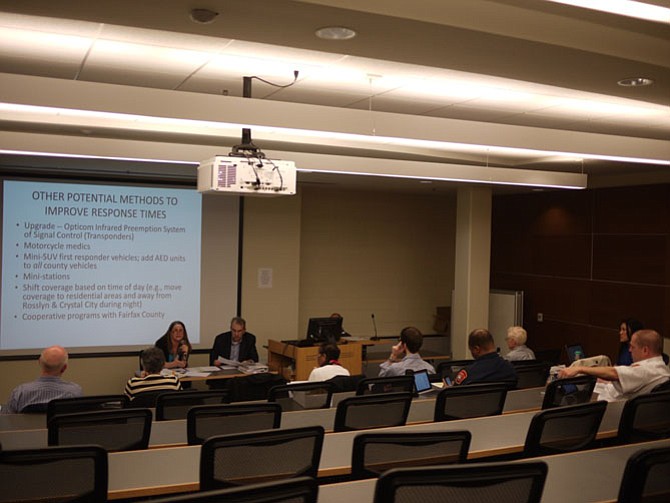“After two years of saying the current site was not adequate for a bigger fire station on the Station 8 site, the county reversed its position and provided site drawings last week indicating the current site was feasible,” said Nancy Williams of the Old Dominion Civic Association. “It would be interesting to know why that took so long,” she said, “but the most important thing is that local citizens were able to get the county to go back review the facts, with a different result.”
The other news at the Fire Station 8 Task Force meeting on April 14 was that some of the options for moving to other locations were no longer viable: Washington Golf and Country Club had indicated lack of interest in selling property on Glebe and Rock Spring which would have been a possible site.
Three subgroups reported to the Task Force on Thursday: the first of these, the response time subgroup, underlined the fact that 7 out of 10 Arlington County fire stations did not meet the ideal response time as outlined by the National Fire Protection Association (NFPA). They also noted that while technically moving the station north to 26th and Old Dominion would make it physically possible to reach three quarters of the problem areas within six minutes, there were problems with that: one quarter of the area would remain outside that six-minute window, and even more concerning, the actual time travelled (TT) had never been physically modeled by the Arlington County Fire Department but had only been “eye-balled” on a map of Arlington. Lastly, the subgroup noted, hotspots which need attention now are not necessarily reflective of future conditions such as the VHC land swap or the Lee Highway plan.
Time travelled reduction is a good goal, the group added, but there are other ways of reducing the total response time. The Opticom system which synchronizes stop lights so that fire trucks can get through lights more quickly was not installed, for some reason, on two intersections that were created a few years ago on North 26th and Glebe and Old Dominion. Call processing time also has to go down to under a minute — the NFPA window — in order to improve total response times. The subgroup highlighted TriData’s highly critical report on the Call Processing Time (CPT), and its comment that “Dispatch Center technology and staffing is much less expensive than adding units and stations to reduce total response time.”
The second subgroup to report was the siting subgroup. Other than providing the news that the county had reviewed the current site and provided a site plan for a three or four bay station on the old site, the subgroup reviewed such factors as hot spots and property availability. This group noted it was industry best practice to locate a fire station in or near hot spots. The Virginia Hospital Center is such a hot spot. Task Force members asked why VHC gets 200 911 calls a day. They learned that if a person is at the hospital and having a stroke, 911 is called to get transported to the ER. This holds true for breaking a leg, having a baby, or any other emergency that takes place at the hospital.
The Finance Subgroup provided a report on what various options would cost. Noel Simon cautioned the group that the $14.1 million estimated cost budget item was not an absolute figure: it would be better to think of it as a guideline, and that the county would also look at the merits of a more expensive option, but going too far above that line would have to be justified. Questions came up about whether the fuel pump had to remain with the fire station or could be located elsewhere, since it serves the whole county, and whether the temporary site would be a rented structure or a purchased one. The county had prepared a budget figure which reflected purchasing the temporary structure; they will go back and get the figure for a rental. The question of whether the county should or would purchase the adjoining property was debated, as was the issue of whether the new fire house would be three or four bays. Finance data has to be reviewed and revised for the next meeting so that the options have clear price tags.
Local residents were upbeat about what had happened since the original debate on the fire station took place last year. Williams and other members of the community remained confused over what took the county so long to acknowledge the current site is in fact adequate, why the relocation to 26th and Old Dominion was so vaunted as a solution since the TriData report never mentioned it as an option, and why, over two years ago, then Fire Chief Jim Schwartz omitted the TriData information on call processing times in his briefing to the county on the issues. Williams has cited numerous examples of lack of communication in county government which have been made more apparent during the task force effort.
SImon closed the meeting on April 14 with a reminder to attendees: “each meeting is more important than the last.” The task force aims to address the community’s interest in improving response times — transparently, equitably, and intelligently, and with community input. He urged the approximately 30 attendees to go back to their constituencies and come prepared to the next meeting on April 28 at 7 p.m. at a location to be announced.
All the subgroup documents are on the task force website: see: www.projects.arlingtonva.us.
